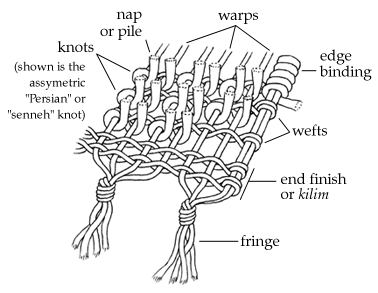Parts of an Oriental Rug
Warps are the parallel strings stretched from loom beam to loom beam upon which rows of knots are tied. Most weavers use cotton for warp material if it is available because it is easier to weave a flat, straight rug on cotton warps than on wool warps (wool yarn is more elastic than cotton string, and is more affected by changes in humidity). Weavers who are semi-nomadic pastoralists (i.e. not farmers) are much more likely to use wool than cotton for warp and weft.

Wefts run across the width of the rug, over and under the warp strings and between rows of knots. Most often wefts are made of cotton, wool, or silk . Wefts help hold rows of knots in place and strengthen the structure of the rug.
Knots are tied by looping yarn around pairs of warps and cutting off the standing end. The ends of the "knot" become the pile or nap of the rug.
Edge bindings are made by wrapping several warps at the edge of the rug with yarn to reinforce this part of the rug.
End finishes hold knots and wefts from working off the rug's warp strings. Many rug types have a flat-woven kilim selvedge at both ends.
Fringes are formed by gathering and knotting together bundles of warp strings at both ends of the rug after the rug has been cut from the loom. The knots in these bundles of warp strings keep pile knots and end finishes tight at the rug's ends.
Design parts

The field is the background of the rug inside the borders.
The main border is the widest decorative design around the outside of the rug; guard borders are the narrow decorative designs flanking the main border.
The medallion is the round, oval, or polygonal design element that sometimes occupies the center of the field.
Corner brackets or spandrels are designs which sometimes fill the corners of the field.
Carpet Sizes
In the Manifacture of cerpets some words express certain sizes. Tehese were first used in Kayseri and then spread all over Anatolia. Although these expressions are also used in other regions, the dimensions given here may differ from 10 to 20 cm.
| Yastik | 60 X 90 cm. |
| Ceyrek | 90 X 135 cm. |
| Kisa Yolluk | 70 X 200 cm. |
| Seccade | 120 X 180 cm. |
| Saf | 110 X 230 cm. |
| Karyola | 150 X 230 cm. |
| Kelle | 300 X 200 cm. |
| Taban | 6 m2 and over. |